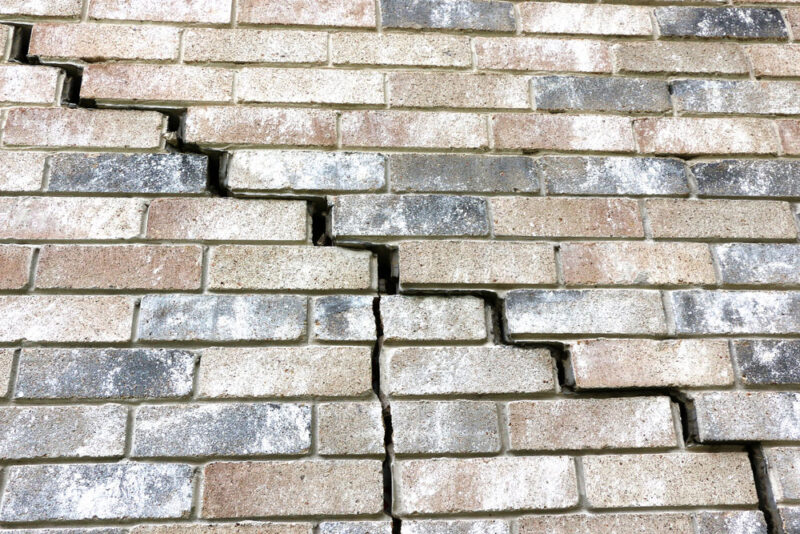Voids are one of the most misunderstood parts of our business. 95% of all voids are caused by lifting a foundation using piles. When a structure is lifted 3 inches, then it will have a 3 inch void underneath. This new atmosphere will start working on exposed parts of the unsupported structure. How is that you ask? It is just air! Air is poison for an unsupported structure. The new air allows the soil to dry. When it dries, it shrinks, and if your structure is sitting on it then it also starts to sink. This is usually structures that are supported on the exterior with piles and now the inside can dry and drop because the inside is sitting on the ground.
When we do jobs for architects or engineers, they design a repair plan to either void fill with mud or foam. This is usually done on commercial buildings. Trying to tell this to a homeowner is difficult. Convincing them to buy a service that prevents the structure from sinking in the center 5 to 10 years from now is hard to sell when it doesn’t absolutely have to be done. To perform the job properly, holes have to be drilled inside the structure every 3 to 6 feet from the center. This depends on the size of the void and how the material flows under the slab. Most owners don’t want holes drilled inside to prevent something that might happen.
Streem uses polyurethane foam for small void fill jobs. We have a special foam that creeps and doesn’t lift. When void filling you don’t want to create pressure under the slab because then you could lift it off the piles holding it up. This void fill foam kind of plays dead and doesn’t expand too much. Void fill is just to remove the air under the slab.On larger jobs we use either mud mixed with 10 to 20% cement to make a pumpable slurry. This slurry is mixed to a consistency to let the material flow from drilled hole to hole.
On large buildings we use a concrete pump to pump in a concrete flowable fill that we have used to lift and level the local steel mill and other buildings like these. The buildings are 3000 ft. long and have floors 36 inches thick. These huge heavy buildings have 3-inch cracks in them, and we lift and repair them in 1 day once all the holes are drilled. The most slurry we pumped in one day was 50 yards of material. The pump we use can pressurize cement slurry up to 800 PSI to hydraulically void fill and then lift the most massive structures with huge 200-ton machines to align the concrete and pipes running to adjacent structures. When we receive a call to lift a large structure and the customer has contacted the other 100 companies in the coastal bend and we are the only ones that show up for the bid and have the equipment to do the job, it is a good feeling knowing we have the experience behind us to solve virtually any lift.

Damage Caused By Void
Causes of Voids Under Concrete Foundations
Voids under a concrete foundation are either from lifting the foundation or related to moisture. In some cases, these causes can’t be avoided. But there are situations where you can prevent these problems from causing foundation damage. These three causes include the following:
- Lifting a foundation — If you’re foundation has sunk and needs to be lifted, when you lift, a gap will be left that should be filled.
- Erosion from pluming leaks or poor water drainage — If you’re foundation wasn’t built in a way that would draw water away from it, the increased chance of erosion can cause a void to form. Poor drainage and improper sloping can lead to the loss of foundation soil, which is important to the property’s structural support. In many cases, it will cause voids to form underneath. Bad plumbing under the foundation can also contribute to void formation. Water building up from leaky pipes under building structures will lead to more soil erosion.
- Soil settlement — Cracks in you walls and ceilings can be the result of normal house settling, but they can sometimes be the symptoms of a more serious problem. Major soil settlement can cause voids to form under a concrete slab. Soil settlement is a natural process, but it can be exacerbated by the erosive behavior of water that isn’t being drained properly.
Be sure to speak to a professional for more tips on how to prevent soil erosion around your foundation.
When a Void Under Your Concrete Foundation Needs to be Repaired
Voids under your concrete foundation can lead to settlement, which can cause the following symptoms:
- Buckling walls.
- Tilted or leaning walls.
- Uneven floors with dips and bowls.
- Complete foundation disruption.
All of these are clear signs that the structural integrity of your concrete foundation needs to be regained.
Methods for Void Filling Under a Concrete Foundation
There are three main void fill techniques for a concrete foundation, which include the following:
- Mudjacking — The sand-cement slurry (which is called “mud” in the industry) can be used to fill voids under a concrete foundation. The mixture is pumped through holes that are drilled into the slab, so it can be used to fill voids that are located underneath. While this technique can be cost-effective, it does have its drawbacks. Void penetration isn’t always exhaustive, and it can lead to future damage. It can also take two or three weeks for the mixture to completely cure (depending on the amount of airflow).
- Foam Injection — This innovative method of foundation void filling uses a polyurethane foam to make the slab more stable. It’s injected into small holes that are drilled into the concrete. And once it’s injected, the chemical reaction will cause an expansion that will fill and seal any voids. Polyurethane foam won’t be affected by water or overly-saturated soil, which can be an advantage if void aren’t holding water. And because the slab can be used immediately afterwards, the downtime will be minimal.
- Sectional Slab Repair — This technique involves repairing specific sections of a concrete slab. Once the void has been identified, the concrete over that area can be broken up so the void can be accessed. It can then be filled with sand and sealed with a concrete mixture that’s level with the slab, but it must be properly compacted so the void doesn’t reform.
If you’re looking for a place that specializes in Corpus Christi foundation repair, be sure to reach out to Stream Foundation Repair. We have a team of experts that can fix a variety of foundation issues, and we would be happy to speak with you about your specific needs.
